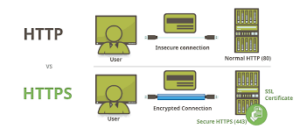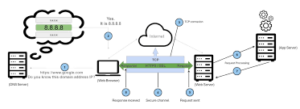Browser security represents a comprehensive framework of strategies and protocols designed to safeguard users and their sensitive information while they navigate the online landscape. This framework encompasses various tools aimed at thwarting unauthorized access, defending against harmful software, and mitigating other potential threats associated with web browsing. Furthermore, it incorporates methods to uphold the privacy of users’ online activities.

At the heart of adequate browser security are critical elements such as secure communication protocols like HTTPS, which play a pivotal role in encrypting data as it travels across networks. Browsers also come equipped with features that identify and block harmful websites, phishing scams, and malicious software. Additionally, there are technical strategies implemented to ensure that the browser operates independently from the underlying operating system, thereby enhancing overall security.
However, it’s essential to recognize that robust browser security is not solely reliant on technology; user behaviour plays an equally significant role. Users must remain alert regarding the sites they visit, the files they download, and the personal information they disclose online. By combining technological safeguards with informed user practices, we can cultivate a safer and more reliable online experience.
The significance of browser security cannot be overstated in today’s digital age; the Internet has woven itself into nearly every aspect of our lives. As primary gateways to this vast digital realm, web browsers serve as essential tools for accessing myriad services and information sources. Given this central role, ensuring robust browser security is imperative—not only for protecting individual privacy but also for maintaining the integrity of online transactions and communications.

With an ever-growing volume of sensitive data being exchanged over the Internet—ranging from financial records to personal correspondence—the need for secure web browsing experiences becomes increasingly critical in safeguarding against identity theft, fraud attempts, and unauthorized intrusions into both personal and professional domains.
Moreover, the importance of browser security reaches far beyond individual users; it carries broader implications for society at large as well as economic stability. Cybersecurity breaches can erode public trust in digital systems while leading to substantial financial repercussions and disruptions in vital services. In light of these realities, implementing strong measures for browser security is crucial not only for protecting individuals but also for fortifying businesses and government entities against cyber threats.
In summary, a multifaceted approach that integrates advanced technological solutions with proactive user engagement is essential in creating a secure digital environment—one where individuals can confidently navigate their online activities without fear or hesitation.
Advancements in Browser Security Technologies for 2024
As we step into 2024, the landscape of browser security is set to undergo significant transformations, with isolation technologies taking centre stage. These innovations are not merely enhancements; they represent a fundamental shift in how we safeguard our online experiences. By effectively isolating browser activities from the core operating system, these technologies create a protective barrier that significantly curtails the potential spread of malware beyond the confines of the browser itself.

At the heart of browser isolation lies a sophisticated methodology: executing web processes within distinct environments such as virtual machines or containers. This strategic separation ensures that any malicious content encountered while surfing the web remains confined within a controlled space. As a result, users can navigate online without fear that harmful elements will infiltrate their systems or compromise sensitive information. The advancements anticipated in 2024 promise to bring about more streamlined and user-friendly implementations of these isolation techniques. Some browsers are expected to incorporate seamless cloud-based isolation designed explicitly for high-risk activities. By shifting the burden of processing and rendering potentially harmful content to secure servers located in the cloud, this approach further mitigates risks associated with attacks on users’ devices.
However, it’s not just about enhancing security; these innovations also prioritize maintaining an uninterrupted browsing experience without sacrificing performance. Users will enjoy safer online interactions while still navigating smoothly through their favourite websites.

In tandem with these developments, biometric authentication is poised to revolutionize how individuals verify their identities within browsers. This technology has emerged as a robust and convenient alternative to traditional password systems, gaining traction as we move further into 2024. With the increasing integration of advanced methods such as fingerprint scanning, facial recognition, and iris scanning into web browsers, users can expect an elevated level of security that far surpasses what passwords can offer.
By harnessing unique biological traits inherent to each individual, biometric authentication creates formidable barriers against unauthorized access attempts on personal accounts and sensitive data. This growing trend reflects a broader movement towards creating more personalized and secure experiences in digital spaces. This evolution resonates deeply with users seeking both safety and simplicity in their online interactions.
Moreover, embracing biometric authentication simplifies login procedures across various online platforms by eliminating the need for complex password memorization while simultaneously diminishing vulnerabilities associated with phishing scams and identity theft threats. In essence, this dual approach—leveraging both isolation technologies and biometric verification—heralds an exciting new era for browser security in 2024, where users can feel confident exploring the digital realm without compromising their safety or convenience.

Revolutionizing Identity Verification: A New Era of Decentralization
In the realm of online identity management, decentralized identity verification is ushering in a transformative change. By harnessing the power of blockchain technology, this innovative method empowers individuals to take charge of their personal information, effectively removing the reliance on traditional centralized authorities for identity validation. Within the sphere of browser security, decentralized identity frameworks enable users to authenticate themselves to websites and digital services without having to share sensitive personal data over the Internet. This advancement not only bolsters privacy but also fortifies security by minimizing vulnerabilities associated with data breaches and identity theft.
Through this technology, individuals can confidently share verified credentials with trustworthy services while safeguarding their information from potential interception or exploitation. As we look ahead to 2024, the incorporation of decentralized identity verification into web browsers will pave the way for online interactions that are both safer and more tailored to user needs.
Emerging Trends Shaping Browser Security in 2024
As we move into 2024, an intensified emphasis on privacy is set to dominate discussions surrounding browser security. Users are becoming increasingly aware of how their data is gathered, stored, and utilized by various websites and online platforms. This growing awareness has spurred a significant demand for web browsers equipped with advanced privacy features—such as automatic tracking protection mechanisms, encrypted DNS queries, and more transparent privacy settings—all designed to protect users against intrusive tracking practices employed by advertisers and third parties.

The emergence of browsers and extensions dedicated solely to enhancing privacy underscores this trend. These tools provide sophisticated functionalities that allow users to block unwanted trackers, manage cookies more effectively, and thwart fingerprinting attempts—empowering individuals to reclaim control over their online privacy. Such a shift towards prioritizing privacy not only influences user behaviour but also compels web developers and businesses alike to embrace practices that respect user confidentiality.
The Ascendancy of Browser-Based Wallets
Another notable development in 2024 is the integration of virtual wallets directly within web browsers—a trend exemplified by the rise of cryptocurrency wallets. This evolution reflects an increasing convergence between digital finance and everyday internet usage as users seek seamless ways to manage their financial transactions alongside their browsing activities. The inclusion of these wallet functionalities within browsers signifies a growing recognition of the need for integrated solutions that cater not just to browsing but also facilitate secure financial operations in one cohesive environment.
In summary, as we venture further into 2024, both decentralized identity verification systems and enhanced browser security measures are set to redefine our online experiences—promoting greater autonomy over personal data while fostering an ecosystem where safety remains paramount amidst an ever-evolving digital landscape.
The growing reliance on web browsers as essential platforms for conducting financial transactions and managing digital assets is becoming increasingly evident. With the rise of browser-based wallets, there is a heightened demand for sophisticated security measures to safeguard users against threats such as phishing and social engineering attacks.

One significant advancement in this realm is the feature of cross-device synchronization, which has now become commonplace in modern web browsers. This functionality allows users to effortlessly access their bookmarks, history, passwords, and preferences from a variety of devices. As we move into 2024, the security ramifications of this convenience are more critical than ever before. Browsers are progressively adopting end-to-end encryption for data that is synchronized across devices, ensuring that user information remains confidential and secure during transmission over the Internet. This shift underscores the necessity for comprehensive security strategies that protect user data not just on individual devices but throughout their entire digital landscape.
To further enhance these protective measures, robust authentication methods—such as biometric verification—are becoming vital in securing synchronized information. As we navigate through 2024, it’s clear that these advancements are not merely optional; they are essential components in safeguarding our online interactions.
Additionally, the ongoing evolution of web standards is poised to have a profound impact on browser security this year. New protocols and technologies are emerging with the aim of improving both user experiences and online safety measures. A key development in this area is the rollout of HTTP/3—the latest iteration of Hypertext Transfer Protocol—which brings enhanced security features alongside faster and more reliable connections. HTTP/3 utilizes QUIC, an innovative transport layer network protocol designed to minimize latency and prevent connection-blocking issues, thus significantly boosting both the security and efficiency of web communications.

Moreover, as web authentication standards continue to evolve, they are reshaping how users verify their identities online. These advancements not only reinforce individual privacy but also contribute to a more secure digital environment overall. In summary, as we embrace these changes throughout 2024 and beyond, it becomes increasingly important to prioritize holistic approaches to security that encompass all aspects of our interconnected digital lives.
As we look ahead, it becomes increasingly evident that the landscape of web authentication is undergoing a significant transformation. The traditional reliance on passwords is giving way to a new era where users can authenticate themselves through a variety of more secure and user-friendly methods. These innovative approaches include biometrics—such as fingerprint and facial recognition—alongside the use of mobile devices and Fast Identity Online (FIDO) security keys. This evolution not only enhances security measures but also provides a robust framework for web browsers to implement authentication processes that effectively guard against threats like phishing attacks, man-in-the-middle intrusions, and the ever-present risk of password breaches.
In contemplating the future, particularly in 2024 and beyond, we can anticipate continued evolution within browser security driven by rapid technological advancements and shifting user expectations. This progression is marked by the integration of isolation technologies that create safer browsing environments alongside biometric authentication methods that offer seamless access without compromising security. Furthermore, decentralized identity verification systems are beginning to take root, reflecting an emerging trend towards new web standards designed to bolster online safety.

These developments have profound implications; they pave the way for an online experience that prioritizes security, privacy, and ease of use for individuals navigating the digital realm. As these innovations unfold, they protect sensitive personal information and financial data while simultaneously fortifying our digital ecosystem against an array of increasingly sophisticated cyber threats.
As we navigate this changing landscape together—users, developers, and organizations alike—it becomes abundantly clear that our dedication to enhancing browser security has never been more crucial. By fully embracing these emerging technologies and trends, we collectively contribute to fostering a safer internet environment for all users. In doing so, we lay the groundwork for a digital future characterized by resilience against potential threats while ensuring that our online interactions remain secure and trustworthy.
Maxthon
Maxthon has introduced a remarkable suite of digital improvements designed to transform how individuals engage with the web. At the heart of these enhancements lies an advanced rendering engine that dramatically boosts performance, allowing users to load web pages—particularly those rich in multimedia—at incredible speeds. What sets Maxthon apart from other browsers is its groundbreaking cloud synchronization feature, which seamlessly links your bookmarks, browsing history, and settings across all devices, whether you’re using a desktop computer, tablet, or smartphone. This capability guarantees a consistent and fluid online experience no matter where you find yourself.

In addition to this innovative feature, Maxthon boasts an effective ad-blocking tool that can be activated with ease at any moment. This built-in functionality successfully eliminates disruptive advertisements while also enhancing page loading times, culminating in a more enjoyable browsing experience overall. Another impressive feature of Maxthon is its split-screen browsing option; this allows users to view two web pages simultaneously—a fantastic asset for research purposes or product comparisons without the hassle of toggling between different tabs.
Furthermore, Maxthon includes a handy resource sniffer tool that simplifies the task of locating downloadable media files on any webpage. With this functionality integrated directly into the browser itself, saving videos and music becomes straightforward and doesn’t require any extra software installations. For those who take pleasure in customizing their online spaces, Maxthon provides an array of themes and layouts to modify the browser interface according to personal tastes. Adjusting these elements can significantly enhance usability and overall enjoyment while navigating the web.
Privacy-conscious users will also find solace in Maxthon’s robust privacy protection features. Tools such as incognito mode and anti-tracking mechanisms are designed to safeguard user data and ensure a secure online environment. All these features come together to create an exceptional browsing experience tailored for today’s internet user, who values speed, convenience, customization, and privacy.
